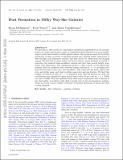| dc.contributor.author | McKinnon, Ryan | |
| dc.contributor.author | Torrey, Paul | |
| dc.contributor.author | Vogelsberger, Mark | |
| dc.contributor.author | McKinnon, Ryan Michael | |
| dc.contributor.author | Torrey, Paul A. | |
| dc.date.accessioned | 2017-05-01T13:37:00Z | |
| dc.date.available | 2017-05-01T13:37:00Z | |
| dc.date.issued | 2016-03 | |
| dc.date.submitted | 2016-01 | |
| dc.identifier.issn | 0035-8711 | |
| dc.identifier.issn | 1365-2966 | |
| dc.identifier.uri | http://hdl.handle.net/1721.1/108526 | |
| dc.description.abstract | We introduce a dust model for cosmological simulations implemented in the moving-mesh code arepo and present a suite of cosmological hydrodynamical zoom-in simulations to study dust formation within galactic haloes. Our model accounts for the stellar production of dust, accretion of gas-phase metals on to existing grains, destruction of dust through local supernova activity, and dust driven by winds from star-forming regions. We find that accurate stellar and active galactic nuclei feedback is needed to reproduce the observed dust–metallicity relation and that dust growth largely dominates dust destruction. Our simulations predict a dust content of the interstellar medium which is consistent with observed scaling relations at z = 0, including scalings between dust-to-gas ratio and metallicity, dust mass and gas mass, dust-to-gas ratio and stellar mass, and dust-to-stellar mass ratio and gas fraction. We find that roughly two-thirds of dust at z = 0 originated from Type II supernovae, with the contribution from asymptotic giant branch stars below 20 per cent for z ≳ 5. While our suite of Milky Way-sized galaxies forms dust in good agreement with a number of key observables, it predicts a high dust-to-metal ratio in the circumgalactic medium, which motivates a more realistic treatment of thermal sputtering of grains and dust cooling channels. | en_US |
| dc.description.sponsorship | United States. Department of Energy (DE-FG02-97ER25308) | en_US |
| dc.language.iso | en_US | |
| dc.publisher | Oxford University Press | |
| dc.relation.isversionof | http://dx.doi.org/10.1093/mnras/stw253 | en_US |
| dc.rights | Creative Commons Attribution-Noncommercial-Share Alike | en_US |
| dc.rights.uri | http://creativecommons.org/licenses/by-nc-sa/4.0/ | en_US |
| dc.source | arXiv | en_US |
| dc.title | Dust formation in Milky Way-like galaxies | en_US |
| dc.type | Article | en_US |
| dc.identifier.citation | McKinnon, Ryan; Torrey, Paul and Vogelsberger, Mark. “Dust Formation in Milky Way-Like Galaxies.” Monthly Notices of the Royal Astronomical Society 457, no. 4 (February 2, 2016): 3775–3800. | en_US |
| dc.contributor.department | Massachusetts Institute of Technology. Department of Physics | en_US |
| dc.contributor.department | MIT Kavli Institute for Astrophysics and Space Research | en_US |
| dc.contributor.mitauthor | McKinnon, Ryan Michael | |
| dc.contributor.mitauthor | Vogelsberger, Mark | |
| dc.contributor.mitauthor | Torrey, Paul A. | |
| dc.relation.journal | Monthly Notices of the Royal Astronomical Society | en_US |
| dc.eprint.version | Author's final manuscript | en_US |
| dc.type.uri | http://purl.org/eprint/type/JournalArticle | en_US |
| eprint.status | http://purl.org/eprint/status/PeerReviewed | en_US |
| dspace.orderedauthors | McKinnon, Ryan; Torrey, Paul; Vogelsberger, Mark | en_US |
| dspace.embargo.terms | N | en_US |
| dc.identifier.orcid | https://orcid.org/0000-0001-9018-1180 | |
| dc.identifier.orcid | https://orcid.org/0000-0001-8593-7692 | |
| dc.identifier.orcid | https://orcid.org/0000-0002-5653-0786 | |
| mit.license | OPEN_ACCESS_POLICY | en_US |
